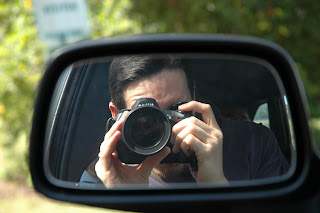In fact, Wave Rock proper is really only a small part (down near the ground on the north side) of a very large granite outcrop. At first I was a bit confused; I'm used to the grey granite of south-east Queensland (e.g. at Girraween National Park near Stanthorpe), but in keeping with the generally red soil of the area, Wave Rock is made of quite pink granite.
We arrived around 4pm, and checked in to the caravan park, which is right at the base of Wave Rock. After finding our cabin, we went for a walk to check out the wave. This rock became famous when a photo of it appeared in National Geographic in 1967.
Along the top is a low wall (actually a series of walls) that's part of the water supply catchment for the area. The water that runs down off the granite rock, which climbs up quite a long way above the wave feature at the base, is caught by the wall and directed into a dam at the north-western end.
 |
| Water catchment retaining walls. The one at the bottom (left in this photo) you can also see in the first photo of the rock above, if you look closely (click photo to enlarge). |
 |
| Boulders breaking off |
 |
| View out to Lake Magic, a salt lake with water (!) and a resort |
 |
| More boulders |
The person you can see down the bottom right of the photo on the left there is another photographer who was there that night. I saw him again several more times the next day.
At dawn the next day, we convinced each other to get up early for some more photos of and on the rock. The wind up there was bitterly cold! But so worth it.
After breakfast we packed up and put our things in our hire car (the front of which was by now completely covered in dead bugs, from the previous day's driving). We went first to check out Lake Magic.
 |
| You can see lumps of salt crystals forming on everything the water touches |
 |
| The sand around the edge is literally carpeted with salt! |
 |
| You can tell how cold the wind was by how much I'm wearing |
Then it was time to head off to Kalgoorlie. We chose the unsealed route to Southern Cross because it was significantly shorter.
Not far along the road we stopped briefly to look into Mulka's Cave, which has old aboriginal hand-prints all over the walls.











No comments:
Post a Comment